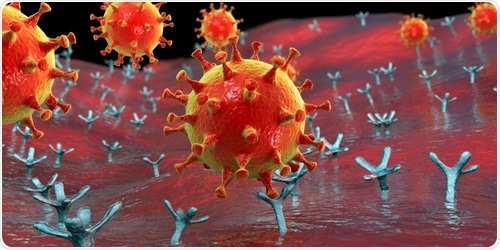Angiotensin-converting enzyme 2 (ACE2), a protein found on the surface of lung cells, facilitates the entry of the novel coronavirus into host cells. While targeting ACE2 can be a potential treatment against COVID-19, there is still some ambiguity about how ACE2 works. To this end, researchers in UAE dug deeper into ACE2 and its role in COVID-19 infections, in a comprehensive review.

Targeting the sub-cellular localization and trafficking pathways of the SARS-CoV-2 receptor protein ACE2 can help control its levels and thereby decrease the severity of infection. Photo courtesy: Shutterstock
While the scientific community has made significant headway in the fight against the coronavirus pandemic, the race to find effective treatment strategies is still ongoing. For this, it is imperative to understand exactly how the virus attacks the human host cells.
One way in which the virus enters lung cells is through interaction with angiotensin-converting enzyme 2 (ACE2), a cell-surface protein. In this regard, ACE2 is a double-edged sword: it plays a vital role in controlling blood pressure, but by facilitating the entry of the SARS-CoV-2 virus into host cells, it can impact the severity and infection rates of COVID-19. This has prompted ongoing research to focus on targeting ACE2 as a treatment strategy against COVID-19. However, various aspects of how ACE2 acts within cells and its regulatory mechanisms remain unexplored. Could taking a deep dive into these mechanisms help us uncover novel therapeutic targets? A team of researchers from the United Arab Emirates University decided to find out, in their review published in Human Genomics.
Describing their motivation, corresponding author of the review Dr. Bassam R. Ali explains, “To enter our cells, the coronavirus must unlock the ‘padlock’ on the cell surface: the ACE2 receptor. This is why, any changes in the ACE2 receptor will likely alter viral entry. In our study, we aimed to expand our knowledge on ACE2 as well understand how its genetic variations can impact severity of infection across different individuals.”
The scientists started by explaining the basics: ACE2 is widely expressed across various tissues in the body, including lung cells, and has several isoforms (functionally similar structures) and single-nucleotide polymorphisms (genetic variants due to a change in only one nucleotide of the DNA sequence) across populations. These genetic variants can alter host susceptibility to SARS-CoV-2 by either decreasing or enhancing the virus-receptor interaction. This could possibly explain the varied effects of SARS-CoV-2 infections in different groups of people.
Further, the scientists explain that ACE2 gene is located on the X chromosome (one of the two sex chromosomes in mammals), and thus certain “epigenetic” mechanisms may be causing sex-biased susceptibility to SARS-CoV-2 infections.
The researchers go on to shed light on how the ACE2 protein moves within the cell. After synthesis, ACE2 undergoes folding and processing in the endoplasmic reticulum. It is also subjected to several modifications (called post-translational modifications) that aid its transport and function. It is then transported via vesicles into a structure called “the Golgi apparatus” for further processing. This process, collectively, is highly systematic and tightly regulated, with several molecules acting as “ACE2-interacting partners.” Further, ACE2 also undergoes shedding or proteolytic cleavage as a mechanism of regulating its expression. The researchers highlight that gaining insights into how ACE2 interacts with its regulatory molecules can uncover novel molecular targets for inhibition of ACE2 and, potentially, reduce the severity of infection.
Overall, this study brings to light novel targets for controlling ACE2 expression and explains why individual responses to SARS-CoV-2 vary. Targeting these intricate pathways that regulate ACE2 functions can help us to control its expression and thus explore novel treatment options. Not just this, the team is confident that their findings can be used to understand other respiratory viruses that use ACE2 as an entry point for infections.
Prof. Ali talks about the clinical applications of their study, “Our findings explain the observed variability in the susceptibility and severity of SARS-CoV-2 infections and their consequent adverse effects. Understanding the diverse effects of the ACE2 receptor’s genetic variants can help us identify novel ways to tackle the virus.”
When it comes to findings strategies against COVID-19, this study has—no doubt—opened many doors.
Source:
Journal reference:
Badawi, S & Ali, B.R., (2021) ACE2 Nascence, trafficking, and SARS-CoV-2 pathogenesis: the saga continues. Human Genomics. doi.org/10.1186/s40246-021-00304-9.